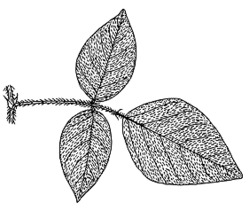
Description: Shrubs or herbs.
Leaves alternate, pinnately 3-foliolate, sometimes 1–5-foliolate; stipules striate, scarious; stipellate.
Inflorescences terminal or axillary racemes or clusters; bracts simple, sometimes caducous. Calyx tube short, upper 2 teeth ± fused. Standard oblong to ± circular, clawed; wings oblong, usually joined to the middle of the keel; keel obtuse. Stamens diadelphous or sometimes monadelphous; anthers uniform. Ovary sometimes sessile, with c. 2 ovules; style inflexed or incurved.
Pod transversely jointed, separating into 1-seeded articles; articles 1–8, usually indehiscent; seeds rarely arillate.
Distribution and occurrence: World: c. 50 species, tropical & subtropical regions. Australia: c. 3 species (all naturalised), all mainland States.
The circumscription of the genus has been greatly reduced in recent years based on molecular data requiring the genus to be split greatly to recognise monophyletic genera. For Australia, only introduced taxa remain in Desmodium. Species native to New South Wales are now placed in the genera Desmodiopsis, Grona, Maekawaea, Oxytes, Pedleya, Pleurolobus and Pullenia.
Text by C. Gardner & T. A. James; updated by R.L. Barrett, Sept. 2019, June 2021
Taxon concept: Generic limits follow a series of papers published by H.Ohashi et al. in the Journal of Japanese Botany (2018-2021).
| | Key to the species | |
| 1 | Leaves 1-foliolate; bracts filiform. | Pleurolobus gangeticus |
| Leaves mostly 3-foliolate, occasionally a few 1-foliolate or 5-foliolate; bracts not filiform. | 2 |
| 2 | Branches spinescent; petioles 2–4 mm long; leaflets oblanceolate to oblong, 0.3–2.5 cm long, 1–6 mm wide. | Pedleya acanthoclada |
| Branches not spinescent; petioles >4 mm long; leaflets various, 0.5–10 cm long, 5–45 mm wide.
Back to 1 | 3 |
| 3 | Leaflets with a conspicuous silver stripe on upper surface. | Desmodium uncinatum |
| Leaflets uniformly green on upper surface.
Back to 2 | 4 |
| 4 | Pod articles inflated; leaflets lanceolate, 4–10 cm long, 4–10 times longer than wide. | Desmodiopsis campylocaulon |
| Pod articles flat; leaflets smaller and/or less elongate.
Back to 3 | 5 |
| 5 | Leaflets hairy on both surfaces. | 6 |
| Leaflets ± glabrous on upper surface.
Back to 4 | 7 |
| 6 | Leaflets with both surfaces appressed-pubescent; apex of leaflets ± obtuse; flowers purple, c. 6 mm long. | Maekawaea rhytidophylla |
| Leaflets with both surfaces sparsely to densely hairy; apex of leaflets acute to acuminate; flowers pink to blue, c. 10 mm long.
Back to 5 | Desmodium intortum |
| 7 | Lower surface of leaflets sparsely hairy with minute, hooked hairs, often appearing glabrous; leaflets drying ± blue-black. | Oxytes brachypoda |
| Lower surface of leaflets sparsely to densely hairy with longer, appressed hairs, sometimes with hairs restricted to veins; leaflets not drying blue-black.
Back to 5 | 8 |
| 8 | Stipules 5–15 mm long. | 9 |
| Stipules 2–6 mm long.
Back to 7 | 10 |
| 9 | Stems and lower surface of leaflets ± densely hairy, appearing whitish; racemes c. 12-flowered. | Grona nemorosa |
| Stems and lower surface of leaflets mostly sparsely hairy or ± glabrous, not appearing whitish; racemes 10–100-flowered.
Back to 8 | Grona heterocarpos |
| 10 | Leaves with terminal petiolule similar to lateral ones, ≤1 mm long; leaflets ± rhombic and truncate at the apex or rarely broad-obovate or rounded. | Pullenia gunnii |
| Leaves with terminal petiolule longer than lateral ones, usually 2–4.5 mm long; leaflets lanceolate, oblong or oblanceolate.
Back to 8 | Grona varians |
|


